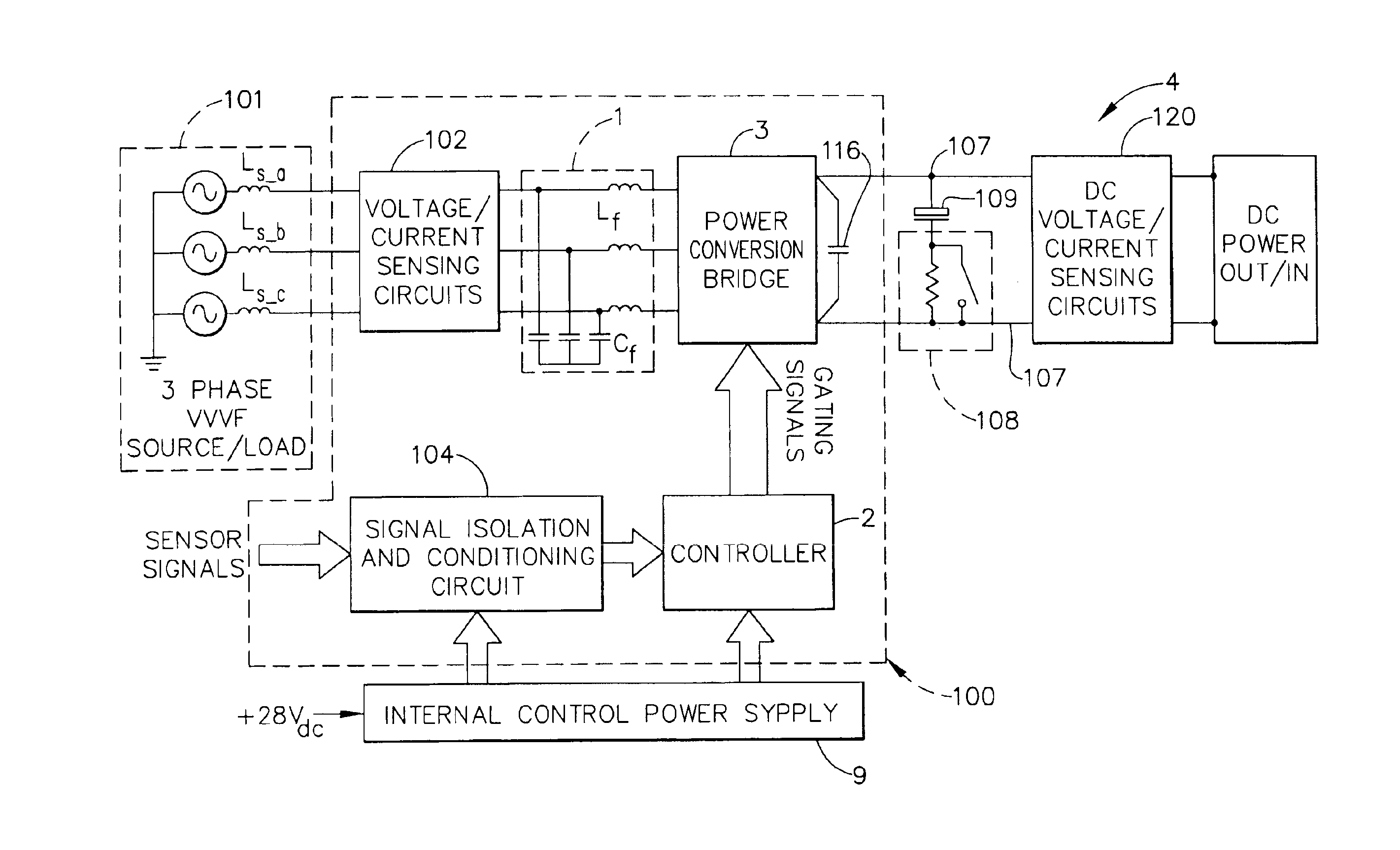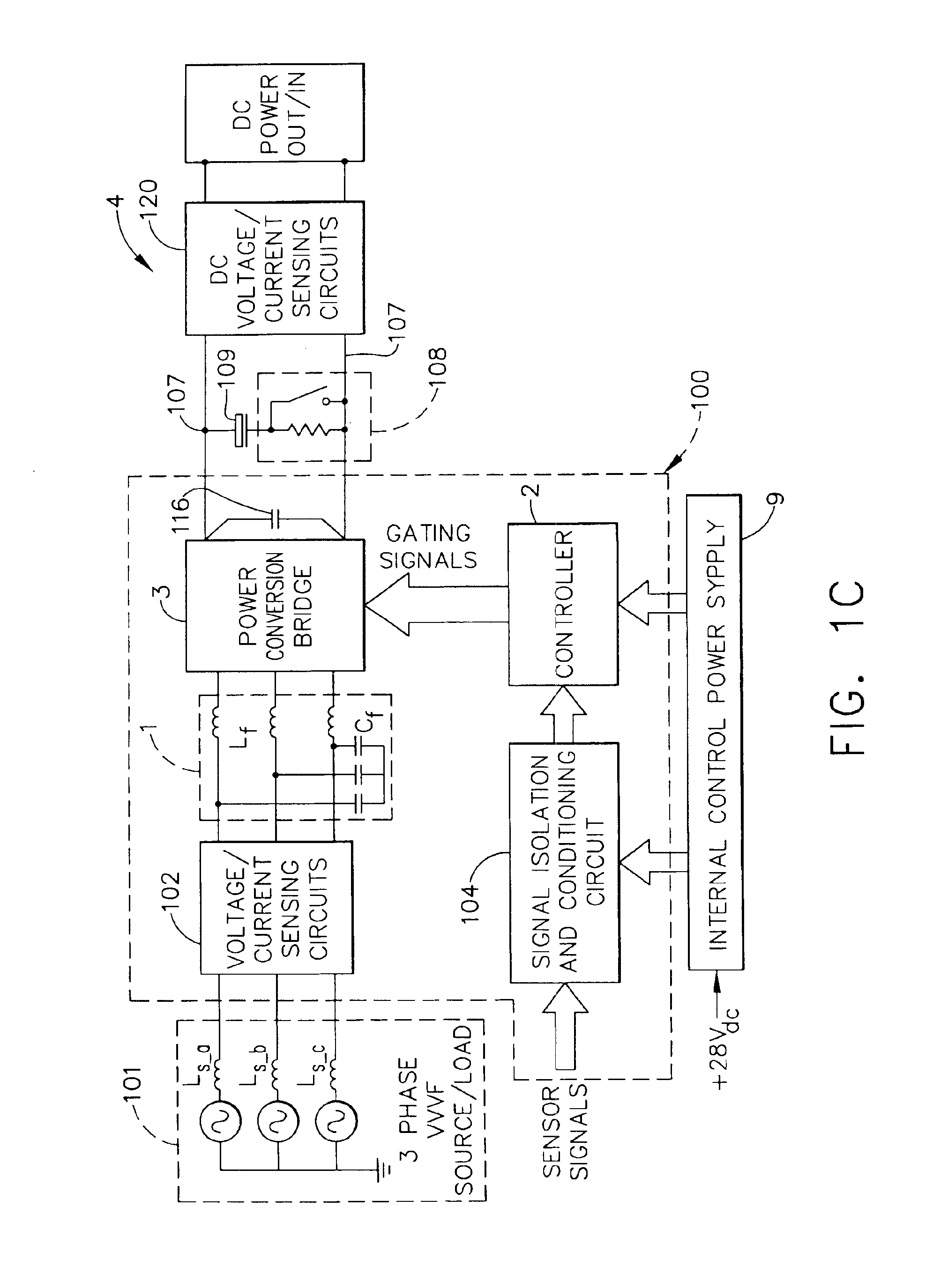This is not an easy task when the generator is on the shaft of an aircraft's engine.
However, this approach poses a fundamental problem because certain types of loads are sensitive to variations in the supply frequency.
Since power for a typical fan / pump load is proportional to the cube of frequency, in this VF power
system, the load is subjected to a
power demand that is eight times its rating and is consequently damaged.
This results in overheating of the load and can cause eventual damage.
The use of
active rectification for
aerospace and other industrial applications has been hindered by the complexity of the design, inherent failure
modes, and excessive cost of these systems.
In particular, the technique disclosed in U.S. Pat. No. 6,038,152 developed by D. E. Baker suffers from the following problems:The control method does not provide a regulated
DC bus voltage;The control method can not be used to provide a higher value than the normal
three phase diode rectification level;The proposed method uses a fixed four pulse gating pattern, which cannot provide the benefits of a closed-loop gating pattern control with high dynamic performance and ability to control the fundamental component of the AC system voltage in real time due to a very low
switching frequency.
Therefore this method is not suitable for high dynamic performance DC-AC loads such as adjustable speed drives;Implementation of memory-based gating patterns are based on feed-forward pre-calculated switching patterns and would not allow for real
time error correction in case of deviation from the assumed
system model; andFurthermore, this reference suggests that implementation of an active
rectifier with a 10 kHz
switching frequency to meet
power quality requirements of
aerospace for VF systems is impractical due to excessive power losses and can not be achieved.
More particularly, the control structure /
algorithm is complex, tuning of the controller parameters is not straightforward and the implementation is not cost effective as it requires high
digital signal processing throughput.
Furthermore, large filter components and excessive thermal management is required due to a very high
switching frequency of 20 kHz for the controlled devices, which significantly increases the cost and weight of the overall system.
Lack of a
robust control method and proper synchronization suitable for the wide frequency variation range of 320-800 Hz for
aerospace variable frequency systems has hindered the acceptance of prior art active rectifiers / inverters as a viable solution for aerospace high power conversion / utilization applications.
These traditional power conversion systems suffer from poor reliability, excessive cost and weight and lower
power density.
Prior art power conversion equipment is not easily scalable, flexible or configurable to support modular building blocks for cost-effective next generation power conversion equipment with much improved
power density, reliability and minimal thermal management requirements.
Finally, the packaging, manufacturing and maintenance of most of the existing power conversion equipment is tedious,
time consuming and expensive.
However, power
electronics systems are sampled data systems and are non-linear.
A high switching frequency requires high
digital signal processing throughput, is expensive to implement and results in poor efficiency due to excessive switching frequency losses.
This demands bulky and expensive thermal management systems.
For practical reasons a very high switching frequency is not affordable due to these problems and the fact that present high power
semiconductor devices such as IGBTs, mainly used for power conditioning systems, are limited to switching frequencies well below 20 kHz.
The development and implementation of nonlinear Digital Phase Lock Loop (DPLL) systems have been hindered for power
electronic systems due to the complexity of nonlinear and discrete
control theory.
Prior art PLLs are not suitable for a wide variable frequency power system due to the following reasons:Limited frequency tracking capability;Difficulty in designing the
loop filter and tuning the parameters of the required controllers (in most cases, a proportional-integral, i.e., a PI controller); andStability analysis and implementation is not straightforward due to the measurement time-delays and the fact that the
nonlinear system is only modeled as a second
order system.
Additionally, the prior art implementation of analog PLLs is subject to op-amp offsets, drift and parameter variations.
The digital PLLs require high sampling rate, require a lot of on-line calculations and are difficult to implement.
However, these power conversion technologies can not be effectively used for future commercial transport applications because they suffer from:
Excessive weight yielding a very low
power density;High cost due to custom made parts and approach;Low reliability due to excessive number of component count and lack of proper health monitoring and protection coordination;Low efficiency due to excessive power losses in the power electronic devices and associated filters; andLarge size due to excessive partitioned functional blocks and poor design partitioning / integration.
Some of the reasons why such “conventional” motor controls technologies can suffer from these problems include the following:Separate “logic power supply” with many voltage levels utilized;“Centralized Controls” concept is used with multiple control boards and logic / power interconnects for controlling the motor using mainly analog circuitry or non-optimized custom-made digital circuits with relatively low
digital signal processing throughput Control structure / algorithm not optimized for bi-directional and wide variable frequency power systems;Power pass
inverter realized by discrete devices and are custom made and very expensive;Bulky sensors and expensive methods used for
signal measurement (current, voltage temp, speed, etc.) and
high voltage signal isolation;
Gate driver circuit design is custom made for each application and does not have all the necessary protection and diagnostics functions to effectively
handle failure
modes at the device level;Extensive use of bulky and expensive power interconnect (e.g.,
Bus Bars);
DC Bus of 270 VDC and AC voltage of 115V, 400 Hz.
The main limitation being the fact that the
DC bus is obtained by natural
three phase diode rectification and can be significantly lower or higher and the AC system has to be 400 Hz
fixed frequency;Extensive use of expensive and fragile logic interconnect;Limited BIT and lack of comprehensive power sequencing (such as soft-start / stop and ride-through) protection coordination, health monitoring and
prognostics and
fault tolerance circuitry results in poor functional performance and / or reliability;Bulky and expensive EMI and
power quality filters for input and output;Bulky and expensive custom made thermal management;Low
energy density high voltage capacitors are custom made and used as bulk “DC link” capacitors.
These are temperature dependent, expensive and difficult to
package;The developed motor controls are not flexible to accommodate different types and sizes of motor drives (
Induction Machine,
Permanent Magnet Synchronous Machine (PMSM), and wound field SM); andLarge size
chassis required due to low power density and excessive volume required to
package the different subassemblies.
 Login to View More
Login to View More  Login to View More
Login to View More 


